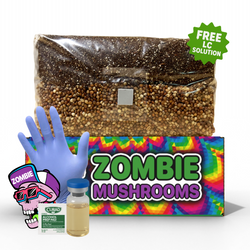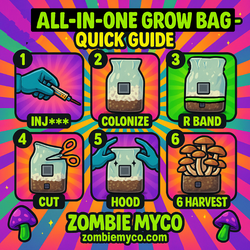⬇️ Prefer to listen instead? ⬇️
- 🌡️ Optimal colonization occurs between 70°F–75°F, while fruiting requires a cooler 55°F–65°F.
- 💧 Mushrooms need consistent humidity of 85%–95% during fruiting to prevent pin abortion.
- 🌬️ Poor air exchange leads to CO₂ buildup causing tall stems and undersized caps.
- ⚠️ Contamination from molds and bacteria is a leading cause of failed mushroom farming.
- 🧪 Ideal substrate pH is slightly acidic—5.5 to 6.5—to prevent unwanted microbial growth.

If your mushroom stems are shooting up like giraffes and their caps are looking puny, you’re seeing what growers call legginess. Here are the top 8 causes — and how to fix them.

Temperature: Important for Growth
Temperature is one of the most important environmental factors in mushroom farming. It affects every stage of development, especially during colonization and fruiting. If you do not control temperatures well, growth can be slow. Mushrooms can also look wrong, or you might lose your whole crop.
Colonization Temperatures
Most commercially-farmed mushrooms, such as oyster (Pleurotus spp.) and shiitake (Lentinula edodes), prefer colonization temperatures in the range of 70°F to 75°F (21°C to 24°C). This warmth makes mycelium grow faster. This means it can get to the fruiting stage sooner.
Fruiting Temperatures
When it comes time to fruit, cooler temperatures are crucial. Most species do best between 55°F and 65°F (13°C to 18°C). Lower temperatures are like outdoor conditions in spring or fall. This makes the mycelium start to reproduce.
Temperature Troubles
-
Too Warm: Speeds contamination and stresses the mycelium, leading to poor fruit structure.
-
Too Cold: Slows metabolism, delaying pinning and making mushrooms stretch causing them to be taller in search of better conditions.
-
Sweet Spot:
-
Colonization: 70–75 °F (21–24 °C)
-
Fruiting: 55–65 °F (13–18 °C)
-
Using digital thermostats, AC units, or heating pads, especially within tents or grow chambers, helps keep these best temperatures for growing mushrooms well.

Humidity: Keeping Moisture for Good Fruiting
Mushrooms are over 90% water, so it’s no surprise that humidity is a very important factor during fruiting. Unlike plants which draw water through roots, mushrooms get it directly from the air. So, moisture in the air is needed for them to grow well.
Ideal Ranges
Maintain relative humidity (RH) levels between 85% and 95% for optimal fruiting. This varies slightly by species, but most edible mushrooms fall within this bracket.
Raising and Controlling Humidity
- Manual misting works well for small hobby setups.
- Ultrasonic humidifiers or cool mist humidifiers connected to humidity sensors can control moisture automatically in larger or commercial operations.
- Humidity tents or bags over mushroom blocks help reduce moisture loss in dry air.
Signs of Imbalance
- Low humidity: Pin aborting, cracked caps, or stunted fruit.
- Excess humidity: Waterlogged substrate, mold overgrowth, slimy textures on caps.
Monitoring with hygrometers ensures your RH stays within the best range for good mushroom growth.
Low Humidity
-
Mushrooms are 90% water — dry air means they can’t develop thick, fleshy caps.
-
Ideal RH: 85–95% during fruiting.
-
Too Low: Causes aborted pins and thin, skinny stems.
-
Fix It: Humidifiers, humidity tents, or regular misting (without waterlogging).

Light Exposure: More About Direction Than Growth
Mushrooms aren't photosynthetic, but light still plays an important role as a signal. Light exposure tells the mycelium that it's at the surface and ready to start fruiting.
What Type of Light?
Mushrooms grow well with low-intensity, full spectrum or blue spectrum light (around 6500K). Standard fluorescent lights or LED grow lights work well.
While mushrooms don’t need intense light like plants, consistent indirect lighting greatly improves their shape, how they face, and how dense the clusters are.
Poor Lighting Conditions
-
Mushrooms don’t eat light, but they read it as a signal for shape and direction.
-
Too Little or Uneven Light: Causes phototropism, stems stretch to find light, caps twist, and clusters get uneven.
-
Best Practice: 12 h on / 12 h off cycle with low-intensity indirect light (~6500 K).

CO₂ and Oxygen: Ventilation for Healthy Growth
Proper air exchange is very important in mushroom farming. During the colonization stage, mycelium tolerates higher CO₂ levels. However, for fruiting, too much carbon dioxide can cause problems.
Excess CO₂ / Stale Air
-
In the fruiting stage, mushrooms need plenty of oxygen.
-
Too Much CO₂: Classic cause of tall, thin stems and small caps.
-
Signs: Condensation buildup, musty smell, stems longer than normal.
-
Fix: Manual fanning for small grows or automated ventilation for larger setups.
Monitoring CO₂ levels with a CO₂ sensor helps get the right gas levels during fruiting. It helps make mushrooms bigger and their caps larger without drying out the substrate.
Water Quality and Delivery: Don't Forget About Your Water
Water doesn’t just hydrate—what's in it can affect the substrate and mycelium. Many growers don't pay attention to what's in their water. This can slow growth without you seeing clear signs.
Poor Water Quality or Over/Under Misting
-
Chlorinated or mineral-heavy water can stunt development.
-
Direct Spraying on Caps: Leads to blotches without improving stem girth.
-
Solution: Use filtered/distilled water, mist the air and substrate evenly, and avoid pooling.
Consistent, light misting is like natural dew and rain. It helps pins form and makes mushrooms healthier.

pH Balance of the Substrate: Acidic but Not Too Acidic
A substrate’s pH plays an important role, though it is often not thought about enough, in mushroom cultivation. Acidic environments reduce contamination risks and help fungi grow well.
Wrong Substrate pH
-
A pH outside 5.5–6.5 disrupts nutrient uptake.
-
Poor nutrition equals thin, weak fruit bodies.
-
Adjust With: Lime to raise pH, gypsum to stabilize. Test before and during colonization.
Tip: Always test before inoculation and during the first days of colonization to catch any instability early.

Contamination Risks: The Silent Yield Killers
Contamination is one of the main reasons mushroom growth fails. It often happens quietly, and you might only see slow colonization or odd fruiting.
Contamination Stress
-
Competing molds or bacteria divert nutrients away from your mushrooms, making them leggy.
-
Common Offenders: Trichoderma (green mold), cobweb mold, bacterial blotch.
-
Prevention: Sterilize substrates, keep your workspace clean, remove infected blocks immediately.
Be careful—one contaminated batch can affect an entire grow room if not isolated.
Choosing the Right Substrate
Mushrooms grow on "food" known as a substrate, which varies by species and determines nutrition, water retention, and structure.
Popular Substrate Types
- Oyster mushrooms: Straw, coffee grounds, cardboard.
- Lion’s mane: Hardwood sawdust or supplemented hardwood fuel pellets.
- Shiitake: Aged hardwood logs or sterilized sawdust mixed with bran.
- Reishi: Wood chips or logs with high lignin content.
Recipe for Success
Combine bulk substrates with supplements like:
- Soy hull pellets for nitrogen.
- Bran or wheat flour for added nutrients.
- Gypsum to buffer pH levels.
Pre-sterilized substrate kits, such as those from Zombie Mushrooms, allow growers to skip pasteurization and reduce risks of contamination.
Tools for Controlled Cultivation
To reliably cultivate mushrooms indoors or at scale, certain tools are essential:
Basic Essentials
- Thermometer/Hygrometer: Monitor temperature and humidity quickly.
- Light timer: Automate light cycles for even illumination.
- Humidifier: Maintain high RH effortlessly.
- Digital CO₂ monitor: Ensure air quality is within fruiting standards.
- pH strips or meter: Detect substrate imbalances.
Automation Tools
For commercial or tech-savvy home growers:
- Grow room probes: Track multiple environmental metrics in real time.
- Controller systems (e.g., Arduino, Inkbird): They let you manage the grow room fully automatically.
- Misting/ventilation controls: Respond to live environmental conditions.
Scaling your mushroom farming becomes significantly easier when environmental variables are tracked and adjusted automatically.

Taking the Next Step: From Hobbyist to Harvest Pro
If you're serious about mushroom cultivation, scaling from a casual kit to a full-fledged grow room involves learning about how the environment affects growth and choosing the right tools. Start small, stay consistent, and reinvest in better data—even a basic sensor setup can greatly improve how much you harvest by catching problems early.
Zombie Mushrooms offers ready-to-use kits and add-ons you can set up to help growers grow with control and trust. This makes becoming an expert from a hobbyist a bit easier.

Troubleshooting Common Growth Problems
Here are some quick tips when troubleshooting your mushroom growth:
- No pins or fruiting delays? Check humidity and start the right light and temperature changes.
- Thin, leggy mushrooms? Indicates CO₂ buildup—improve air exchange.
- Discoloration or fuzzy white patches? This might mean mold. Isolate it and check.
- Caps look dry or cracked? Likely low humidity or excessive lighting.
- Water pooling/substrate soggy? Adjust misting frequency and check air circulation.
By keeping a grow journal and tracking adjustments, patterns emerge that make diagnosis and correction much easier for future cycles.
Optimize, Monitor, Harvest
💡 Takeaway: Tall, skinny mushrooms are usually a sign that your fruiting conditions aren’t balanced — most often CO₂ buildup, low humidity, or incorrect lighting. By dialing in these factors, you can swap those lanky stems for plump, healthy caps.
🎯 Subscribe to our newsletter for weekly cultivation tips.
🛒 Look at our mushroom grow kits and probes to make your grow room setup work best.
💬 Share this guide with fellow growers and cultivators in your network!
References
Stamets, P. (2000). Growing gourmet and medicinal mushrooms. Ten Speed Press.
Leatham, G. F. (1982). Cultivation of oyster mushroom: Pleurotus species requirements for optimal growth. Mushroom Journal for the Tropics, 2(3), 6-11.
Royse, D. J., Baars, J., & Tan, Q. (2017). Current overview of mushroom production in the world. In Edible and Medicinal Mushrooms (pp. 5-13). Wiley-Blackwell.
Yang, W., Guo, F., & Wan, Z. (2013). Yield and quality of shiitake mushroom cultivated on corncob substrates supplemented with different additives. Food Chemistry, 138(2-3), 276-281.


